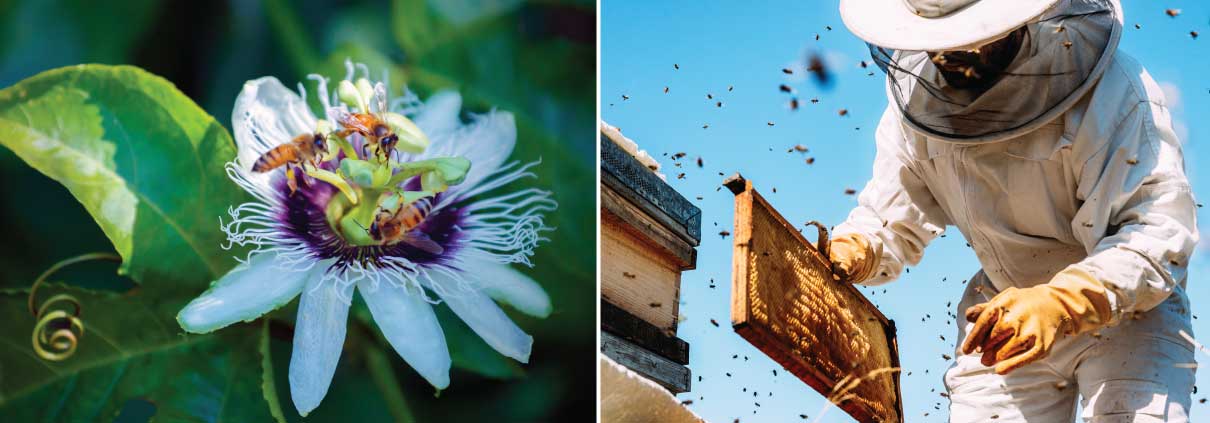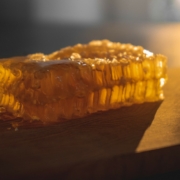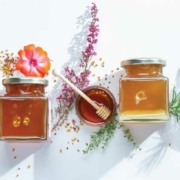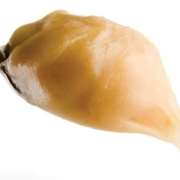The Sweet Journey: How Honey is Made
Reading time: 4 minutes
Honey is a natural sweetener that has captivated the taste buds of humanity for thousands of years. It is not just a product but a testament to nature’s complexity and efficiency. The world of honey naturally begins with the bees and ends in the kitchen, bridging the gap between the natural world and culinary delight.
The Bees
Foraging for Nectar
The journey of honey begins with bees! Specifically, worker bees, the ladies of the hive, venturing out from the hive to collect nectar from flowers. Honeybees, equipped with proboscises (a tube-like tongue), siphon nectar, a sugary liquid flowers produce, into their “honey stomach.”
Nectar Collection and Conversion
After collecting the nectar, bees return to the hive and pass the nectar on to younger bees, known as house bees, through a process called trophallaxis. During this process, the nectar is mixed with enzymes in the bees’ saliva, which starts turning the nectar into honey. The enzymes added by bees, primarily invertase, begin breaking down the complex sugars (sucrose) in nectar into simpler sugars such as fructose and glucose. This enzymatic activity makes the sugars more digestible and less prone to crystallization.
Storing Honey in Comb
Once the house bees process the nectar, it is stored in the honeycomb cells. The honeycomb, a marvel of bee engineering, is constructed by the bees from wax secreted from their bodies. These cells provide the perfect place for honey to mature and thicken. Bees circulate air in the hive by fanning their wings, accelerating evaporation. Evaporation gradually thickens the nectar, turning it into honey.
Capping the Honeycomb
When the honey reaches the ideal consistency, approximately 18% moisture, bees seal the honeycomb cells with a wax cap. This capping process preserves the honey and keeps it from moisture and other contaminants. Beekeepers know the honey is “ripened” and ready for harvest when capped.
Beekeeper’s Role, Hive Management
- Monitoring Bee Health: Beekeepers manage hives to ensure bees’ health and productivity. They monitor the health and productivity of the queen, observe behavior, look for signs of stress or disease, and ensure sufficient population.
- Controlling Pests and Diseases: Beekeepers are always on the lookout for pests and diseases like Varroa mites or American Foulbrood. If something is amiss, there are natural and chemical treatments available. Bees are naturally very clean creatures, but sometimes, the environment gets ahead of them, leaving an opening for problems.
- Nutrition: Some beekeepers leave ample honey in the hive to last through spring when the nectar flow is reliable. Others supplement with sugar syrup or pollen cakes to help the colony remain strong until the nectar flow is generous.
- Hive Maintenance: Beekeepers constantly monitor the hive for damage from weather or animals, ensure ample ventilation, and expand the hive with additional boxes, ideally before the hive swarms!
Harvesting Honey:
- Timing the Harvest: Honey is most often harvested in late summer or early fall. Many beekeepers will also harvest “Spring honey” in early summer. When harvesting in the fall, beekeepers must ensure they leave enough honey for the bees to survive winter.
- Removing the Honeycomb: Frames of ripened honeycomb are gently removed from the hive. Bees don’t appreciate this! Beekeepers generally use a smoker to calm the bees and minimize disturbance while removing frames of honey.
- Extracting Honey: Once the frames are removed, the beekeeper will cut or scrape off the caps, place the frame in a honey extractor, and then spin the frames to force the honey out of the comb by centrifugal force.
- Filtering and Bottling: Extracted honey is generally filtered before bottling. This course filtering still allows the honey to be considered “raw” as it only removes bits of wax and debris from the honey; pollen and healthy nutrients remain.
Sustainability
Honey is the only sugar with a net positive impact on the environment. Responsible beekeepers focus on sustainable practices, proper hive management, and the overall health of the hive.
Quality and Varieties:
Nectar Source: The type and quality of the nectar collected by bees greatly influence the honey’s taste, aroma, and color. For example, nectar from orange blossoms yields an intense citrus flavor and aroma, and honey from a lavender field will produce honey with floral notes; in contrast, buckwheat honey generally has a distinct barnyard flavor.
Processing: Raw, unfiltered honey will retain its natural flavors and nutrients. Heavily processed honey will lose much of its unique character. Heavily processed honey tends to be blended to create a more consistent generic “honey” flavor.
Storage and Aging: How and at what temperature honey is stored can affect its texture and flavor. Honey stored at a consistent temperature is slower to crystalize, but almost all honey will crystalize over time. This natural, expected process does not affect the honey’s quality or indicate spoilage.
Environmental Factors: Humidity, temperature, and general climate of the bees foraging area and where honey is stored play a significant role in quality. The hive location and its surrounding flora will have the most significant impact on the honey taste.
Varieties of Honey:
Floral Varieties: Each flower type gives honey a unique flavor profile. For example, raspberry honey is known for its clean, clear taste, while buckwheat honey is known for its intense barnyard flavor.
Seasonal Varieties: the season nectar is collected will influence honey quality and flavor. Spring honey tends to be lighter, while late-season honey tends to have a more robust flavor.
Honey production is a complex dance between nature and humans, from bees’ meticulous foraging activities and the hive’s complexity to the (hopefully) thoughtful stewardship of the beekeeper. Each step in the process reflects a balance of natural instinct and learned skill.
The variety and quality of honey are not just measures of taste but also a reflection of a healthy (hopefully) and diverse ecosystem and also the dedication of those who tend to them. Each jar of honey is a preserved sampling of one of nature’s most fascinating gifts.





